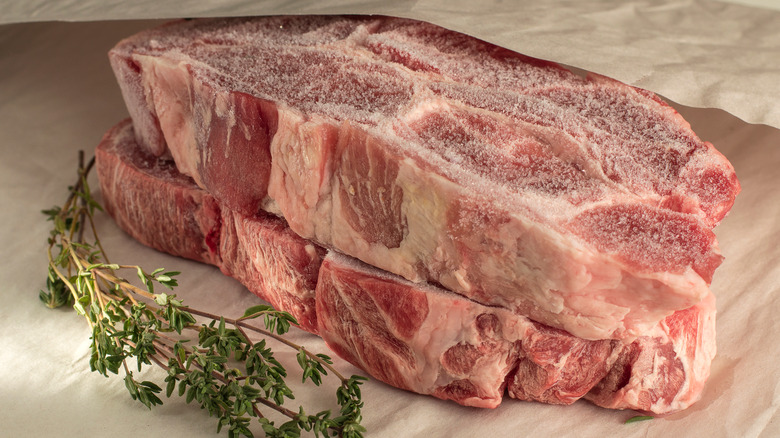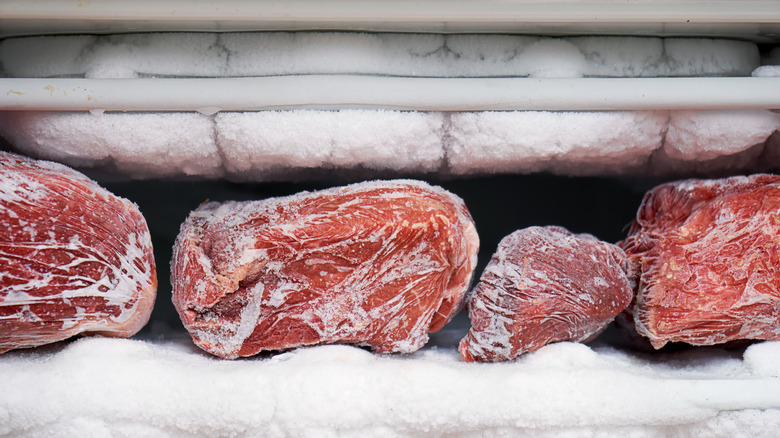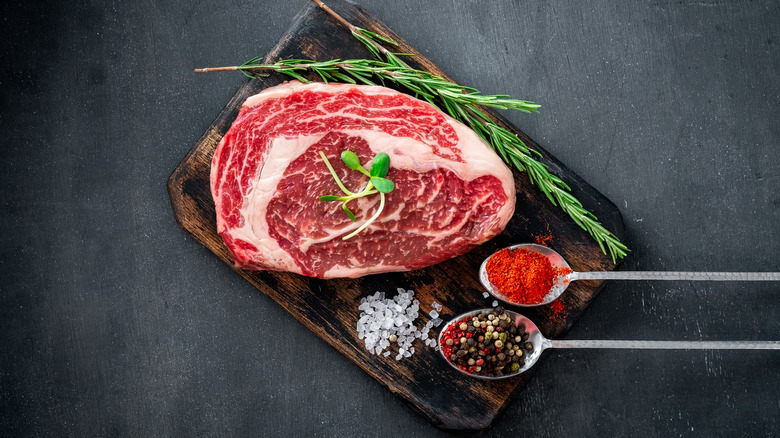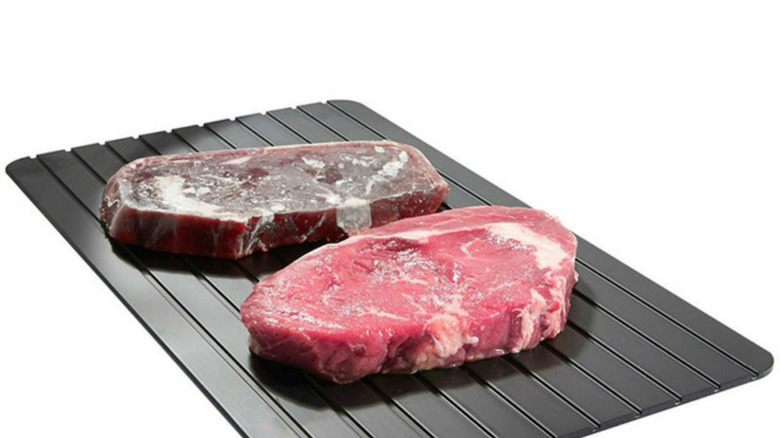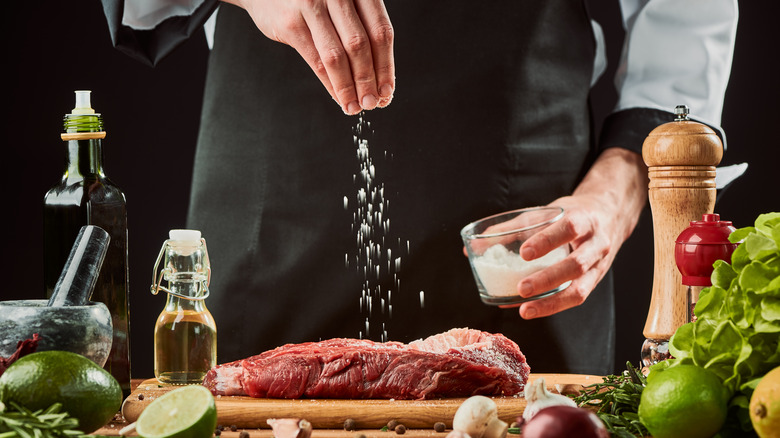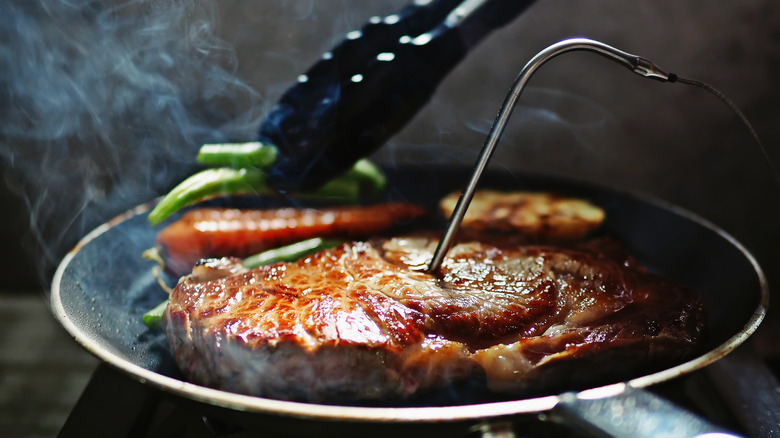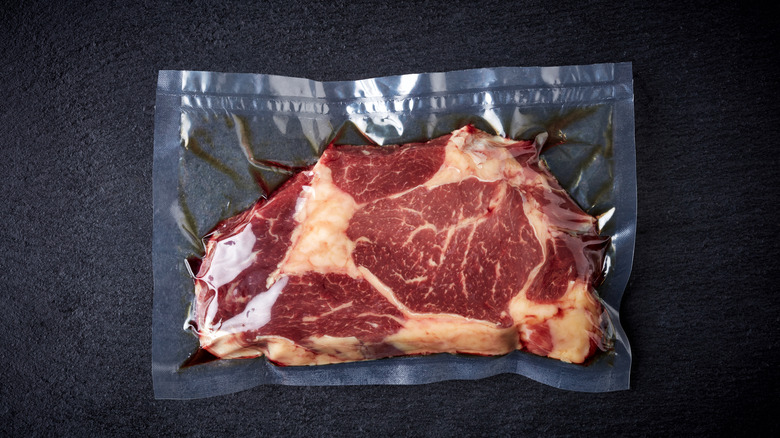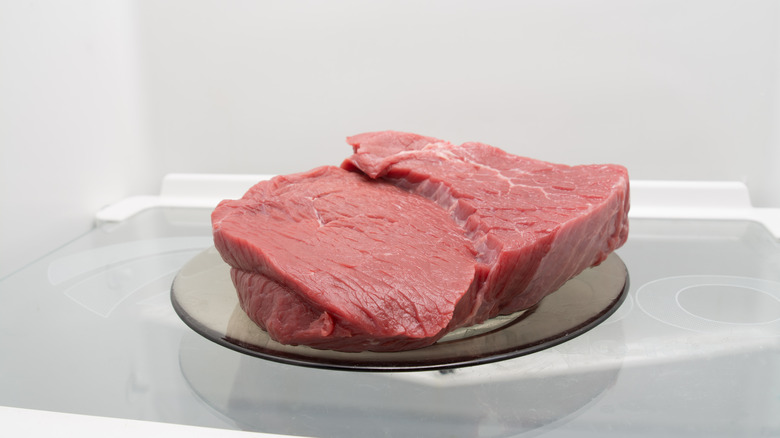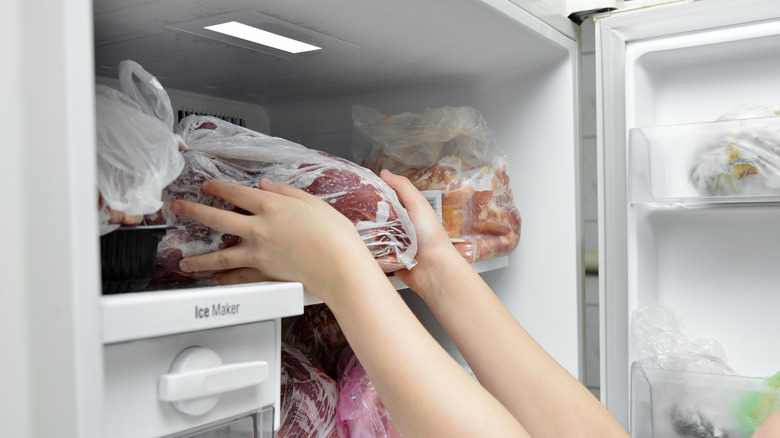Big Mistakes Everyone Makes With Frozen Steaks
One of the best ways to ensure that you have great-quality meat on-hand at any given time is to rely not on fresh, but on frozen steaks. Carter Country Meats, a purveyor specializing in frozen meat, notes that freezing its dry-aged steaks makes for improved flavor and texture, not to mention a longer shelf life. For the home cook, this points to two great options: Either buy your steaks already frozen from a company like Carter Country Meats or Omaha Steaks, known for its premium frozen beef, or freeze it yourself. If you're armed with a big freezer, this even means that you can even go in on a cow share with friends to source the best-quality meat at a truly reasonable price point (via Carnicopia Meats).
But while freezing your steaks is a great choice, it does mean you need to be a bit more careful when cooking them, lest you end up with a dry cut or one suffering from freezer burn. With that in mind, let's take a stroll through common mistakes and misconceptions surrounding frozen steaks — and the best ways to combat them at home for the perfect steak every time.
Freezing steaks in contact with too much air
When freezing your own steaks, it's essential to minimize contact with air. According to Carter Country Meats, reducing contact with oxygen reduces the risk of potentially dangerous bacteria growing on your steak (yuck). Freezing it at a very cold temperature, the company continues, also keeps ice crystals from forming, reducing the risk of the unpleasant flavor and texture associated with freezer burn.
To cut down on contact with both air and moisture, the first step is to remove the meat from its original packaging. Weber recommends wrapping each steak individually in a tight layer of plastic and then placing each wrapped steak in a freezer bag; Popular Science, meanwhile, recommends using aluminum foil as a moisture barrier before wrapping each steak in plastic, or even vacuum sealing your steaks to reduce air contact even further. Once the steaks are wrapped, freeze them at as cold a temperature as possible. You can do this by reducing the temp of your freezer and, as Taste of Home recommends, placing the steaks on the bottom shelf, aka the coldest part of the freezer.
(For what it's worth, Epicurious takes a completely different stance, recommending freezing your steaks completely naked and then wrapping them only after they're frozen, to reduce contact with moisture).
Fearing color change
If you freeze top-quality steaks, chances are they're going to change color from a bright, appetizing red to a grey or brown color ... and that's okay. While studies have shown that discoloration is off-putting to consumers, with 15% of beef discounted due to color change alone, this change is actually perfectly safe. According to Science of Cooking, when meat is vacuum packed close to the time of processing, oxygen molecules are pulled away from the surface of the meat, which turns its surface a browner color. So while discoloration at the retail level contributes to significant food waste and economic loss, seeing a slightly off color to your frozen meat definitely does not mean it should be trashed. Indeed, Science of Cooking notes, cutting it open will reveal that this discoloration has only happened at the surface level — nothing to fear!
Of course, you should never eat meat that's gone off or is spoiled. But this, according to Mythcrushers, is better recognized not by color, but by texture: In addition to its odor, meat that has gone off can be recognized by the tacky sheen that forms on the surface. In this case, of course, you should dispose of the meat without consuming it.
Defrosting steak before cooking it
If you grew up watching your mom put frozen food on the counter first thing in the morning so that it thawed in time for dinner, you may be tempted to treat your steaks the same way. But the truth is that if your steaks are frozen sous vide, you don't actually have to defrost them at all.
Sip Bite Go highlights a great method for cooking frozen steaks by first thawing them in a sous vide bath for 60 minutes. The result is improved texture over defrosting in the fridge or on the countertop (which is more dangerous and should be avoided, according to the USDA). Plus, it means you don't have to decide what you're having for dinner before you've even had breakfast.
Cook the Story, meanwhile, notes that you can actually begin cooking your steaks without defrosting them at all. Simply sear the frozen steaks in very hot oil and then finish them in the oven. They'll cook all the way through — no defrosting needed.
Seasoning frozen steak before cooking it
If you're cooking your steaks right from frozen, you may find that it changes the normal order of your cooking method. Notably, it means that you're going to want to season your steaks after you begin cooking them.
Much has been written about the perfect time to season steaks, with some, like Serious Eats, claiming that the best time is about 40 minutes before cooking, and others, like the Los Angeles Times, claiming that it's best to season right before cooking — or better yet, when the steak is already in the pan. But when it comes to cooking a steak from frozen, you'll want to season after the sear, according to Epicurious. This, of course, makes sense when you think about it: Seasoning will not adhere to the dry, hard surface of an unthawed steak. For Epicurious, then, the best course of action is to sear, then season, then finish your steaks in the oven. The result will be a perfectly seasoned surface and a tender, wonderfully cooked steak.
Neglecting the reverse sear method
In most cases when cooking meat (whether frozen or fresh), you sear the meat first and finish cooking it at a lower temperature (in the oven, for example, or in a liquid as for a braise). However, many proponents of frozen steak prefer the reverse sear method, and it's a great technique to try at home.
For Serious Eats, the reverse sear method affords quite a few advantages over a more typical steak cooking order. Not only is reverse searing less of a time crunch, as it affords more flexibility in cooking time, but it paves the way for not only a browner crust but also a tenderer center. And since frozen beef is often starting out colder in the center, it's the ideal insurance policy for even cooking throughout.
To reverse-sear steak, you first cook it through in the oven, only searing the crust just before serving. It takes a bit longer than more traditional cooking methods, but you'll soon see it's worth it.
Being intimidated by the sous vide technique
If you're lucky enough to have a sous vide machine at home, you can definitely take advantage of it to cook your frozen steaks so that they're tender, juicy, and flavorful. Sous vide is a French technique whereby vacuum-sealed bags of food are cooked at a low, consistent temperature in a water bath. Sous vide machines work by circulating water to maintain this temperature, for wonderfully even cooking (via Simply Recipes). It can take a bit of time to get used to cooking food in a plastic bag, but one bite and you'll soon see it's worth wrapping your mind around.
The perfect sous vide steak cooked from frozen starts before freezing. Izzy Cooking recommends first seasoning your steaks or coating them in a marinade, and freezing them in contact with these flavoring agents. Different marinades, StreetSmart Kitchen notes, will affect the texture and flavor of your steak in different ways, so be mindful of your use of acid, salt, and fat as you consider the outcome you're looking for.
Once your steaks are frozen, a delicious dinner is always within reach. You can drop the whole bag into a pot of water heated with the sous vide machine, cooking until it's reached your desired doneness before cutting it out of the bag, searing for that beautiful crust, and serving.
Defrosting frozen steak too quickly
If you do decide to defrost your frozen steak and cook it in a more traditional way, there's no problem at all ... except that if you defrost it too quickly, you run the risk of having negative effects on the texture of your steak, or even making it dangerous to consume.
There are loads of different ways to defrost meat, from the countertop to the microwave to a sink full of hot water. But not all of these methods are advisable. The USDA recommends thawing meat in the fridge whenever possible, as this method is the best from a food safety perspective. Of course, thawing meat in the fridge is also the slowest method of defrosting: According to Steak School, depending on the size of your piece of meat, it could take a full day or more to defrost safely in the fridge. But it's worth it to reduce the risk of bacterial contamination.
In a pinch, you can also defrost in cold water, which will reduce the thawing time considerably to a few hours. The USDA notes, however, that this method carries a higher risk of bacterial contamination, and it is quite a bit more hands-on. Best to plan ahead and use the fridge.
Not knowing the safety rules of refreezing previously frozen steak
We all know how it goes: You had your eye on a lovely steak for dinner, but something else came up, and now you're stuck with a defrosted piece of meat you've got to eat fast. Or do you?
Myths of the health hazards of refreezing beef have been greatly exaggerated ... but if you do want to refreeze previously frozen meat, there are a few safety protocols to follow to reduce the risk of food-borne illness. According to Kansas City Steaks, it's safe to refreeze steak (and, for that matter, other meat) if it has been defrosted at fridge temperature and has never reached room temperature (or, at least, not for more than two hours). The USDA adds that while there may be moisture loss when refreezing previously frozen meat (meaning a drier steak when you finally do dig in), from a food safety perspective, it is indeed fine to refreeze previously frozen food — whether still raw or cooked — if the food was thawed in the fridge.
